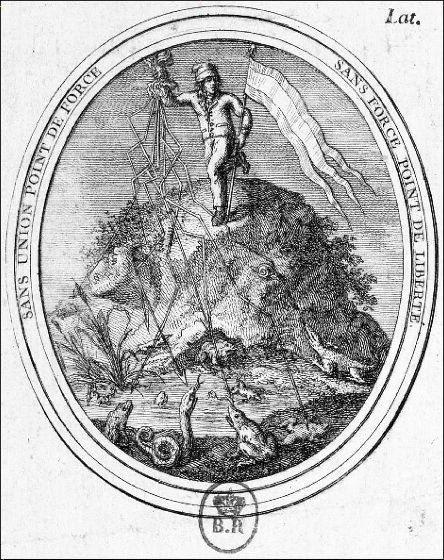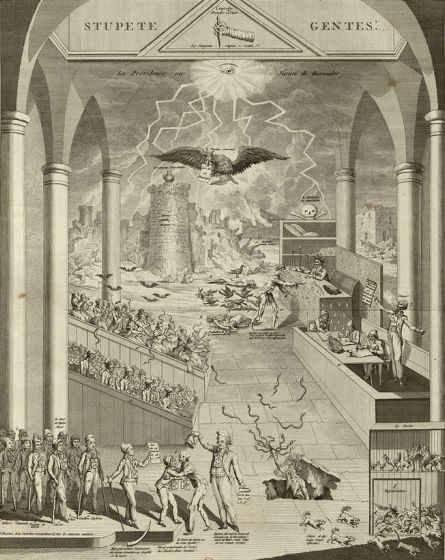What is the meaning hidden behind the "lightning bolt" painted during the French Revolution?
The flow of history is not only to follow the year and events,Change in picture frameIt can be seen from the change of art and fashion such as. Media and media on the history of art and literature by knowing how power and age has changed from the treatment of "thunder" in paintings, etc.The Public Domain ReviewI will explain the transition.
Flash Mob: Revolution, Lightning, and the People's Will - The Public Domain Review
http://publicdomainreview.org/2017/11/09/revolution-lightning-and-the-peoples-will/
Thunder has long been drawn as a symbol of governance, and it can also be used as a symbol of the royal family within the tyranny.Thomas HobbesPublished in 1651LeviathanThunder is drawn in conjunction with the symbol of tyranny, such as crown and cannon.

However, in the French Revolution "lightning" has been handled differently than ever before. December 3, 1792, a revolutionary leader and politicianMaximilian · Robespierre"People do not hear by a judicial judge like a judge, not sentenced to sentence, they will fall like thunder," and on January 21, 1793 Louis XVI was executed . In other words, thunder which was "the symbol of power" by the king has become an expression which pierced the king itself. As you can see from this, thunder has come to be used as a sign of the people's will.
Also, even if you see an illustration of an anthropomorphic "freedom" in the form of a woman, the figure of the woman who raised the fist to depict the thunder is drawn. Women scatter the stagnant clouds expressing the monarchy and carry the light behind them.

Similar expressions can be seen in the illustration below. In this illustration, on August 10, 1792, the people and troops raided Louis XVI and the King of Mary Antoinette by trampling the Tullee PalaceAugust 10 incidentAlthough it is allegoricalizing thunder, thunder has torn clouds and is falling from "mountain" which is another name of Jacobin school.

And the thunder which was released freely will be drawn in the form towards the frog and the snake afterwards. These living beings were sometimes called "marshes" by way of derogationGironde factionWhat represents. In the illustration below, Jacobin schools are turning lightning from heaven to frogs and snakes at the foot of the mountain.

As you can see from the illustrations above, the revolutionary people regarded the people's will as lightning, or "power of nature". Lightning can not be seen until it is actually released, but once it is released, light that is dramatic and absolute appears.
As time goes by, the motif of thunder will gradually be used in criticism of the Jacobins who promoted the revolution. In the illustration below the Jacobin faction is depicted as a zombie that leads the living to death, but on the other side of the personBastille prisonThe thunder which pours down is drawn. Thunder which reached the hands of the revolutionary people from the king became to be used as an anti-revolutionary message this time.

It is not a coincidence that thunder was chosen as a symbol of people's will. At that time science was developing rapidly, and the French Revolution was so close to science that it was called "scientist's revolution". It was a revolutionary leader and a doctorJean-Paul MullerIt is also a scientist who published a paper on electricity. In 1783, Mallah installed a lightning rod at home, but villagers who worried about thunder falling in their homes due to lightning rods asked Mallar to remove lightning rods. It eventually developed to a trial, and Robespierre defeated under the name of science, winning. With this victory Robespierre raised its reputation as a lawyer.
In addition, Robespierre revealed that lightning is electric in experiments using kitesBenjamin FranklinThere was also connection. He was also a discoverer of oxygen and was conducting research on thunderJoseph PriestleyHe is too busy revolutionaryNational AssemblyHe is one of the people involved with having time involved.
The French Revolutionists have been concerned with scientists such as Franklin and Priestley because they regarded it as having a deep relationship between battle for freedom and science. Priestly was politically suspicious in supporting Britain while supporting the French Revolution, and was forced to migrate to the United States. As the revolution, riot, science, and enlightenment progressed simultaneously, the meaning of the motif "thunder" changed as time went by as described above.
Related Posts:
in Note, Posted by darkhorse_log








